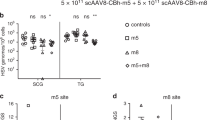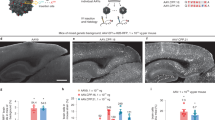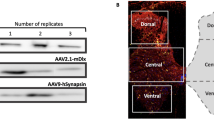Abstract
Rabies virus glycoprotein (RVG) can pseudotype lentiviral vectors, although at a lower efficiency to that of vesicular stomatitis virus glycoprotein (VSVG). Transduction with VSVG-pseudotyped vectors of rodent central nervous system (CNS) leads to local neurotropic gene transfer, whereas with RVG-pseudotyped vectors additional disperse transduction of neurons located at distal efferent sites occurs via axonal retrograde transport. Attempts to produce high-titre RVG-pseudotyped lentiviral vectors for preclinical and clinical trials has to date been problematic. We have constructed several chimeric RVG/VSVG glycoproteins and found that a construct bearing the external/transmembrane domain of RVG and the cytoplasmic domain of VSVG shows increased incorporation onto HIV-1 lentiviral particles and has increased infectivity in vitro in 293T cells and in differentiated neuronal cell lines of human, rat and murine origin. Stereotactic application of vector pseudotyped with this RVG/VSVG chimera in the rat striatum resulted in efficient gene transfer at the site of injection showing both neuronal and glial tropism. Distal neuronal transduction in the substantia nigra, thalamus and olfactory bulb via retrograde axonal transport also occurs after intrastriatal administration of chimera-pseudotyped vectors at similar levels to that observed with a RVG-pseudotyped vector. This is the first report of distal transduction in the olfactory bulb. The enhanced pseudotyping with this envelope should enable easier production of higher-titre pseudotyped lentiviral vectors that exhibit efficient local and dispersed neuronal transduction in the CNS.
This is a preview of subscription content, access via your institution
Access options
Subscribe to this journal
Receive 12 print issues and online access
$259.00 per year
only $21.58 per issue
Buy this article
- Purchase on Springer Link
- Instant access to full article PDF
Prices may be subject to local taxes which are calculated during checkout









Similar content being viewed by others
References
Canivet M, Hoffman AD, Hardy D, Sernatinger J, Levy JA . Replication of HIV-1 in a wide variety of animal cells following phenotypic mixing with murine retroviruses. Virology 1990; 178: 543–551.
Lusso P, di Marzo Veronese F, Ensoli B, Franchini G, Jemma C, DeRocco SE et al. Expanded HIV-1 cellular tropism by phenotypic mixing with murine endogenous retroviruses. Science 1990; 247: 848–852.
Chesebro B, Wehrly K, Maury W . Differential expression in human and mouse cells of human immunodeficiency virus pseudotyped by murine retroviruses. J Virol 1990; 64: 4553–4557.
Spector DH, Wade E, Wright DA, Koval V, Clark C, Jaquish D et al. Human immunodeficiency virus pseudotypes with expanded cellular and species tropism. J Virol 1990; 64: 2298–2308.
Zhu ZH, Chen SS, Huang AS . Phenotypic mixing between human immunodeficiency virus and vesicular stomatitis virus or herpes simplex virus. J Acquir Immune Defic Syndr 1990; 3: 215–219.
Cronin J, Zhang XY, Reiser J . Altering the tropism of lentiviral vectors through pseudotyping. Curr Gene Ther 2005; 5: 387–398.
Bartz SR, Rogel ME, Emerman M . Human immunodeficiency virus type 1 cell cycle control: Vpr is cytostatic and mediates G2 accumulation by a mechanism which differs from DNA damage checkpoint control. J Virol 1996; 70: 2324–2331.
Mazarakis ND, Azzouz M, Rohll JB, Ellard FM, Wilkes FJ, Olsen AL et al. Rabies virus glycoprotein pseudotyping of lentiviral vectors enables retrograde axonal transport and access to the nervous system after peripheral delivery. Hum Mol Genet 2001; 10: 2109–2121.
Mitrophanous K, Yoon S, Rohll J, Patil D, Wilkes F, Kim V et al. Stable gene transfer to the nervous system using a non-primate lentiviral vector. Gene Therapy 1999; 6: 1808–1818.
Wong LF, Azzouz M, Walmsley LE, Askham Z, Wilkes FJ, Mitrophanous KA et al. Transduction patterns of pseudotyped lentiviral vectors in the nervous system. Mol Ther 2004; 9: 101–111.
Mentis GZ, Gravell M, Hamilton R, Shneider NA, O′Donovan MJ, Schubert M . Transduction of motor neurons and muscle fibers by intramuscular injection of HIV-1-based vectors pseudotyped with select rabies virus glycoproteins. J Neurosci Methods 2006; 157: 208–217.
Kato S, Inoue K, Kobayashi K, Yasoshima Y, Miyachi S, Inoue S et al. Efficient gene transfer via retrograde transport in rodent and primate brains using a human immunodeficiency virus type 1-based vector pseudotyped with rabies virus glycoprotein. Hum Gene Ther 2007; 18: 1141–1151.
Federici T, Kutner R, Zhang XY, Kuroda H, Tordo N, Boulis NM et al. Comparative analysis of HIV-1-based lentiviral vectors bearing lyssavirus glycoproteins for neuronal gene transfer. Genet Vaccines Ther 2009; 7: 1.
Mochizuki H, Schwartz JP, Tanaka K, Brady RO, Reiser J . High-titer human immunodeficiency virus type 1-based vector systems for gene delivery into nondividing cells. J Virol 1998; 72: 8873–8883.
Abelseth MK . An attenuated rabies vaccine for domestic animals produced in tissue culture. Can Vet J 1964; 5: 279–286.
Azzouz M, Le T, Ralph GS, Walmsley L, Monani UR, Lee DC et al. Lentivector-mediated SMN replacement in a mouse model of spinal muscular atrophy. J Clin Invest 2004; 114: 1726–1731.
Azzouz M, Ralph GS, Storkebaum E, Walmsley LE, Mitrophanous KA, Kingsman SM et al. VEGF delivery with retrogradely transported lentivector prolongs survival in a mouse ALS model. Nature 2004; 429: 413–417.
Ralph GS, Radcliffe PA, Day DM, Carthy JM, Leroux MA, Lee DC et al. Silencing mutant SOD1 using RNAi protects against neurodegeneration and extends survival in an ALS model. Nat Med 2005; 11: 429–433.
Wong LF, Goodhead L, Prat C, Mitrophanous KA, Kingsman SM, Mazarakis ND . Lentivirus-mediated gene transfer to the central nervous system: therapeutic and research applications. Hum Gene Ther 2006; 17: 1–9.
Backovic M, Jardetzky TS . Class III viral membrane fusion proteins. Curr Opin Struct Biol 2009; 19: 189–196.
Gaudin Y, Ruigrok RW, Tuffereau C, Knossow M, Flamand A . Rabies virus glycoprotein is a trimer. Virology 1992; 187: 627–632.
Doms RW, Keller DS, Helenius A, Balch WE . Role for adenosine triphosphate in regulating the assembly and transport of vesicular stomatitis virus G protein trimers. J Cell Biol 1987; 105: 1957–1969.
Roche S, Bressanelli S, Rey FA, Gaudin Y . Crystal structure of the low-pH form of the vesicular stomatitis virus glycoprotein G. Science 2006; 313: 187–191.
Roche S, Rey FA, Gaudin Y, Bressanelli S . Structure of the prefusion form of the vesicular stomatitis virus glycoprotein G. Science 2007; 315: 843–848.
Rose JK, Doolittle RF, Anilionis A, Curtis PJ, Wunner WH . Homology between the glycoproteins of vesicular stomatitis virus and rabies virus. J Virol 1982; 43: 361–364.
Roche S, Albertini AA, Lepault J, Bressanelli S, Gaudin Y . Structures of vesicular stomatitis virus glycoprotein: membrane fusion revisited. Cell Mol Life Sci 2008; 65: 1716–1728.
Rose JK, Welch WJ, Sefton BM, Esch FS, Ling NC . Vesicular stomatitis virus glycoprotein is anchored in the viral membrane by a hydrophobic domain near the COOH terminus. Proc Natl Acad Sci USA 1980; 77: 3884–3888.
Warrens AN, Jones MD, Lechler RI . Splicing by overlap extension by PCR using asymmetric amplification: an improved technique for the generation of hybrid proteins of immunological interest. Gene 1997; 186: 29–35.
Ganser-Pornillos BK, Yeager M, Sundquist WI . The structural biology of HIV assembly. Curr Opin Struct Biol 2008; 18: 203–217.
Li S, Hill CP, Sundquist WI, Finch JT . Image reconstructions of helical assemblies of the HIV-1 CA protein. Nature 2000; 407: 409–413.
Briggs JA, Wilk T, Welker R, Krausslich HG, Fuller SD . Structural organization of authentic, mature HIV-1 virions and cores. EMBO J 2003; 22: 1707–1715.
Greene LA, Tischler AS . Establishment of a noradrenergic clonal line of rat adrenal pheochromocytoma cells which respond to nerve growth factor. Proc Natl Acad Sci USA 1976; 73: 2424–2428.
Biedler JL, Roffler-Tarlov S, Schachner M, Freedman LS . Multiple neurotransmitter synthesis by human neuroblastoma cell lines and clones. Cancer Res 1978; 38 (11 Pt 1): 3751–3757.
Cashman NR, Durham HD, Blusztajn JK, Oda K, Tabira T, Shaw IT et al. Neuroblastoma x spinal cord (NSC) hybrid cell lines resemble developing motor neurons. Dev Dyn 1992; 194: 209–221.
Geraerts M, Willems S, Baekelandt V, Debyser Z, Gijsbers R . Comparison of lentiviral vector titration methods. BMC Biotechnol 2006; 6: 34.
Funke S, Maisner A, Muhlebach MD, Koehl U, Grez M, Cattaneo R et al. Targeted cell entry of lentiviral vectors. Mol Ther 2008; 16: 1427–1436.
Morimoto K, Hooper DC, Carbaugh H, Fu ZF, Koprowski H, Dietzschold B . Rabies virus quasispecies: implications for pathogenesis. Proc Natl Acad Sci USA 1998; 95: 3152–3156.
Ubeda-Banon I, Novejarque A, Mohedano-Moriano A, Pro-Sistiaga P, de la Rosa-Prieto C, Insausti R et al. Projections from the posterolateral olfactory amygdala to the ventral striatum: neural basis for reinforcing properties of chemical stimuli. BMC Neurosci 2007; 8: 103.
Ikeda Y, Takeuchi Y, Martin F, Cosset FL, Mitrophanous K, Collins M . Continuous high-titer HIV-1 vector production. Nat Biotechnol 2003; 21: 569–572.
Lesch HP, Turpeinen S, Niskanen EA, Mahonen AJ, Airenne KJ, Yla-Herttuala S . Generation of lentivirus vectors using recombinant baculoviruses. Gene Therapy 2008; 15: 1280–1286.
Lesch HP, Laitinen A, Peixoto C, Vicente T, Makkonen KE, Laitinen L et al. Production and purification of lentiviral vectors generated in 293T suspension cells with baculoviral vectors. Gene Therapy 2011; 18: 531–538.
Hoffmann M, Wu YJ, Gerber M, Berger-Rentsch M, Heimrich B, Schwemmle M et al. Fusion-active glycoprotein G mediates the cytotoxicity of vesicular stomatitis virus M mutants lacking host shut-off activity. J Gen Virol 2010; 91 (Pt 11): 2782–2793.
DePolo NJ, Reed JD, Sheridan PL, Townsend K, Sauter SL, Jolly DJ et al. VSV-G pseudotyped lentiviral vector particles produced in human cells are inactivated by human serum. Mol Ther 2000; 2: 218–222.
Pichlmair A, Diebold SS, Gschmeissner S, Takeuchi Y, Ikeda Y, Collins MK et al. Tubulovesicular structures within vesicular stomatitis virus G protein-pseudotyped lentiviral vector preparations carry DNA and stimulate antiviral responses via Toll-like receptor 9. J Virol 2007; 81: 539–547.
Horton RM, Hunt HD, Ho SN, Pullen JK, Pease LR . Engineering hybrid genes without the use of restriction enzymes: gene splicing by overlap extension. Gene 1989; 77: 61–68.
Follenzi A, Naldini L . Generation of HIV-1 derived lentiviral vectors. Methods Enzymol 2002; 346: 454–465.
Pfeifer A, Brandon EP, Kootstra N, Gage FH, Verma IM . Delivery of the Cre recombinase by a self-deleting lentiviral vector: efficient gene targeting in vivo. Proc Natl Acad Sci USA 2001; 98: 11450–11455.
Kutner RH, Zhang XY, Reiser J . Production, concentration and titration of pseudotyped HIV-1-based lentiviral vectors. Nat Protoc 2009; 4: 495–505.
Lamikanra A, Myers KA, Ferris N, Mitrophanous KA, Carroll MW . In vivo evaluation of an EIAV vector for the systemic genetic delivery of therapeutic antibodies. Gene Therapy 2005; 12: 988–998.
Acknowledgements
We thank Dr Edward Wright (University College London, London, UK) for the kind gift of the SNB1 anti-rabies virus GP antibody, and Professor Richard Reynolds and Dr Owain Howell for use of and help with fluorescence microscopy to document histological staining of brain sections. We also thank Dr Egle Solito and Enrico Cristante for letting us use several antibodies. This work was funded by a Seventh Framework Programme European Research Council Advanced Grant No. 23314 to NDM supporting DCJC, AT and SME.
Author information
Authors and Affiliations
Corresponding author
Ethics declarations
Competing interests
The authors declare no conflict of interest.
Rights and permissions
About this article
Cite this article
Carpentier, D., Vevis, K., Trabalza, A. et al. Enhanced pseudotyping efficiency of HIV-1 lentiviral vectors by a rabies/vesicular stomatitis virus chimeric envelope glycoprotein. Gene Ther 19, 761–774 (2012). https://doi.org/10.1038/gt.2011.124
Received:
Revised:
Accepted:
Published:
Issue Date:
DOI: https://doi.org/10.1038/gt.2011.124
Keywords
This article is cited by
-
Persistent elevation of intrathecal pro-inflammatory cytokines leads to multiple sclerosis-like cortical demyelination and neurodegeneration
Acta Neuropathologica Communications (2020)
-
A note on retrograde gene transfer efficiency and inflammatory response of lentiviral vectors pseudotyped with FuG-E vs. FuG-B2 glycoproteins
Scientific Reports (2019)
-
Optogenetics – New Potentials for Electrophysiology
Neuroscience and Behavioral Physiology (2019)
-
Development of in vitro and in vivo rabies virus neutralization assays based on a high-titer pseudovirus system
Scientific Reports (2017)
-
Tropism, intracerebral distribution, and transduction efficiency of HIV- and SIV-based lentiviral vectors after injection into the mouse brain: a qualitative and quantitative in vivo study
Histochemistry and Cell Biology (2017)



